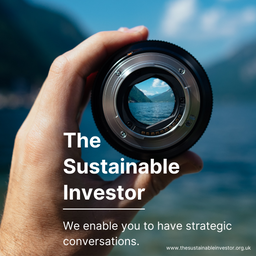
Why The Sustainable Investor?
"If you aren't thinking about owning a stock for 10 years, don't even think about owning it for 10 minutes" (Warren Buffett).
Building a better understanding of why and how sustainability issues can impact finance, investment, and company strategy.
Sustainability can be a long term value creator for investors
Long term financial value creation is at least partly about anticipating and preparing for future changes, trends and events. The more dramatic the change, the greater the need to prepare.
“In a time of drastic change, it is the learners who inherit the future. The learned find themselves equipped to live in a world that no longer exists.” - Warren Bennis
Some of the most material changes that companies face relate to sustainability. These include the direct and indirect impacts of climate change, and the social issues around how companies relate to their workforce and their local communities.
Some of these changes will be driven by regulation, the will of the people expressed via the politicians. But much of the change that companies face will happen regardless of what governments do.
The changing climate will impose on companies new costs and risks - driving the need for adaptation. And when combined with technological advancements, it will also create new opportunities. New ways of providing the goods and services customers want, and are willing to pay for. Many incumbent companies could fall by the wayside, trying to operate in a world that increasingly doesn't exist anymore.
The other big changes will be social. Part of this will come from changing consumer demands, such as healthier foods. The other part will relate to the relationship with local communities (a different licence to operate) and with those who work for the company. It might be a cliche, but for most companies their people really are their biggest asset. The days of value being created by tangible assets like factories have largely past. Intangibles are the value creator now, and for this to work to their advantage companies need to find better ways of incentivising their workforce.
Companies will act on these sustainability issues if there is a long term financial benefit.
From the perspective of investors, if we want companies to become more sustainable we need to do at least two things. First, we need to link the impact of the upcoming sustainability transitions directly to the company's sources of competitive advantage and their financial strategy. How do they create value now, and how will this likely change in the future.
Second, we need to highlight the long term financial risks and opportunities. What are the financial consequences of action (or inaction)?
From the perspective of a company it's similar. They need to ensure that their financial strategy is aligned with the changes that the sustainability transitions will likely bring. They need to set out how the actions they have chosen will impact their long term financials and value creation. And they need to explain this (disclosure) to their investors in a clear way, with meaningful intermediate actions and outcomes. Put simply, they need to take their investors with them as they transition.
Companies and investors will not become more sustainable just because it's the right thing to do. They need to see a financial benefit.
But that benefit doesn't have to be immediate. This is not about a short term boost to profits. In fact it's better if the changes make the company more sustainable in the long run - this is just a question of long term valuation mathematics. A long term gain is worth way more to the company and it's investors than a short term bump that is then lost.
The opportunities can be from moving into market segments that offer more attractive long term financial returns. Or they could come from better risk management, minimising the hit from possible future negative impacts - regulation, the impact of environmental and social changes, and the emergence of new technologies and business models.
Sometimes these opportunities and risks emerge quickly, but in many cases they will develop over years, or even decades. And so they can be easy to ignore. But even for those risks that emerge slowly, it can make sense to start adapting now, not waiting.
Linking sustainability to investing
How can we make the sustainability related changes actually happen. First, we need to recognise that in many ways the upcoming sustainability changes are no different from other opportunities and risks companies face.
Companies should not treat sustainability as a box ticking exercise. It should be an essential element of their competitive analysis and strategy selection. And they should carefully explain their approach to their shareholders and regularly disclose progress. Sustainability actions can create long term financial value.
And second, while business as usual is often the worst response, change at a company level can be challenging. Which is where investors come in - engaging with management and the board to ensure that sustainability is treated as a key strategy and financial issue. And that the company actually has a meaningful and deliverable plan, that they deliver against.
Sustainability Strategy Investing Finance.
Team with decades of experience

Membership is free

